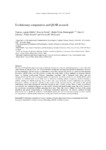Evolutionary Computation and QSAR Research

Ver/
Use este enlace para citar
http://hdl.handle.net/2183/19369Coleccións
- Investigación (FIC) [1728]
Metadatos
Mostrar o rexistro completo do ítemTítulo
Evolutionary Computation and QSAR ResearchAutor(es)
Data
2013Cita bibliográfica
Aguiar-Pulido V, Gestal M, Cruz-Monteagudo, Rabuñal JR, Dorado J, Munteanu CR. Evolutionary computation and QSAR research. Curr Comp Aided Drug Des. 2013;9(2):206-225
Resumo
[Abstract] The successful high throughput screening of molecule libraries for a specific biological property is one of the main improvements in drug discovery. The virtual molecular filtering and screening relies greatly on quantitative structure-activity relationship (QSAR) analysis, a mathematical model that correlates the activity of a molecule with molecular descriptors. QSAR models have the potential to reduce the costly failure of drug candidates in advanced (clinical) stages by filtering combinatorial libraries, eliminating candidates with a predicted toxic effect and poor pharmacokinetic profiles, and reducing the number of experiments. To obtain a predictive and reliable QSAR model, scientists use methods from various fields such as molecular modeling, pattern recognition, machine learning or artificial intelligence. QSAR modeling relies on three main steps: molecular structure codification into molecular descriptors, selection of relevant variables in the context of the analyzed activity, and search of the optimal mathematical model that correlates the molecular descriptors with a specific activity. Since a variety of techniques from statistics and artificial intelligence can aid variable selection and model building steps, this review focuses on the evolutionary computation methods supporting these tasks. Thus, this review explains the basic of the genetic algorithms and genetic programming as evolutionary computation approaches, the selection methods for high-dimensional data in QSAR, the methods to build QSAR models, the current evolutionary feature selection methods and applications in QSAR and the future trend on the joint or multi-task feature selection methods.
Palabras chave
Evolutionary computation
Feature extraction
Genetic algorithms
Genetic programming
Molecular descriptors
Quantitative structure-activity relationship
QSAR
Variable selection
Feature extraction
Genetic algorithms
Genetic programming
Molecular descriptors
Quantitative structure-activity relationship
QSAR
Variable selection
Versión do editor
Dereitos
The published manuscript is avaliable at EurekaSelect
ISSN
1573-4099
1875-6697
1875-6697





